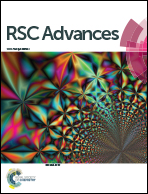Gate-tunable gas sensing behaviors in air-stable ambipolar organic thin-film transistors†
Abstract
Chemiresistive gas sensors, which exploit their electrical resistance in response to changes in nearby gas environments, usually achieve selective gas detection using multi-element sensor arrays. As large numbers of sensors are required, they often suffer from complex and high-cost fabrication. Here, we demonstrate an ambipolar organic thin-film transistor as a potential multi-gas sensing device utilizing gate-tunable gas sensing behaviors. Combining behaviors of both electron and hole carriers in a single device, the proposed device showed dynamic changes depending on gate biases and properties of target gases. As a result, the gas response as a function of gate biases exhibits a unique pattern towards a specific gas as well as its concentrations, which is very different from conventional unipolar organic thin-film transistors. In addition, our device showed an excellent air-stable characteristic compared to typical ambipolar transistors, providing great potential for practical use in the future.



 Please wait while we load your content...
Please wait while we load your content...